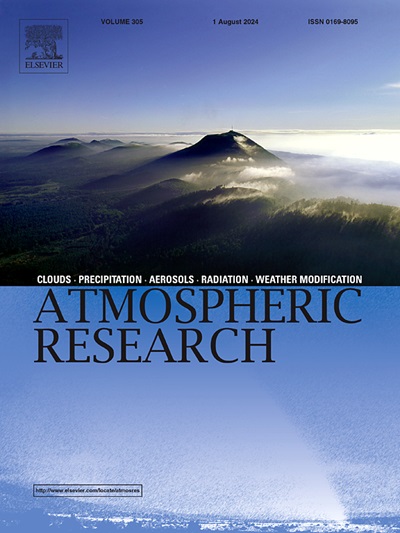Numerical simulation of lightning channel reactivation in recoil leader process
IF 4.5
2区 地球科学
Q1 METEOROLOGY & ATMOSPHERIC SCIENCES
引用次数: 0
Abstract
Lightning development involves transient events that produce non-stationary, abrupt changes in lightning structure. The most prominent (and most studied) examples of reactivation of lightning side branches are recoil leaders that are initiated near the tips of previously decayed positive leader channels. This study proposes a numerical model that, among other things, takes into account evolution of channel temperature profile and is aimed at simulation the recoil leader inception. The model is based on the paradigm of reversal point meandering, which is a consequence of the macroscale asymmetry of development of positive and negative lightning poles. Simulation results allow one for the first time to formulate a physically-based and well-founded mechanism of a negative recoil leader initiation. In particular, it is shown that the channel reactivation is provided by the wave of electric field that starts from the branching point and propagates along a previously decayed (but still heated) leader channel when its per-unit-length resistance does not exceed several thousand Ohms per meter. This resistance corresponds to the channel temperature no less than 3500 K under equilibrium conditions. It is shown that channel reactivation starts somewhere between the branching point and the previously decayed leader tip, in agreement with observations. Additionally, the plasma chemical aspects of the leader channel reactivation are discussed.

反冲先导过程闪电通道再激活的数值模拟
闪电的发展涉及产生闪电结构不稳定、突然变化的瞬态事件。闪电侧分支重新激活的最突出(和研究最多)的例子是在先前衰减的正先导通道的尖端附近启动的后坐力先导。本研究提出了一个数值模型,除其他外,考虑了通道温度分布的演变,旨在模拟后坐力先导的开始。该模式基于反转点蜿蜒的范式,这是正、负雷极发展的宏观尺度不对称的结果。模拟结果允许人们第一次制定一个基于物理的和有充分根据的负后坐力先导起爆机制。特别是,当其单位长度电阻不超过几千欧姆/米时,从分支点开始并沿着先前衰减(但仍然加热)的先导通道传播的电场波提供了通道再激活。在平衡条件下,该电阻对应的通道温度不低于~ 3500k。结果表明,通道重新激活开始于分支点和先前衰减的领导尖端之间的某个地方,与观察结果一致。此外,还讨论了前导通道再激活的等离子体化学方面。
本文章由计算机程序翻译,如有差异,请以英文原文为准。
求助全文
约1分钟内获得全文
求助全文
来源期刊

Atmospheric Research
地学-气象与大气科学
CiteScore
9.40
自引率
10.90%
发文量
460
审稿时长
47 days
期刊介绍:
The journal publishes scientific papers (research papers, review articles, letters and notes) dealing with the part of the atmosphere where meteorological events occur. Attention is given to all processes extending from the earth surface to the tropopause, but special emphasis continues to be devoted to the physics of clouds, mesoscale meteorology and air pollution, i.e. atmospheric aerosols; microphysical processes; cloud dynamics and thermodynamics; numerical simulation, climatology, climate change and weather modification.
 求助内容:
求助内容: 应助结果提醒方式:
应助结果提醒方式:


